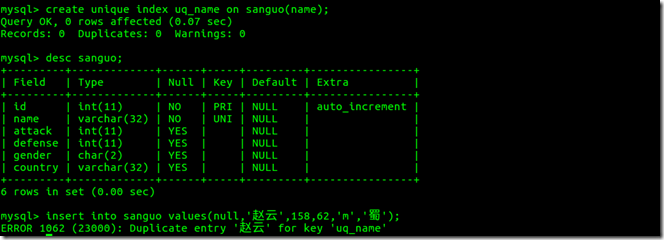赵旭
zhaoxu@tedu.cn
回顾
1.数据库
存储数据的仓库
MYSQL,Oracle,
2.MYSQL特点
1.关系型数据库
2.跨平台
3.支持多款编程语言(python,java,php,.... ....)
4.基于磁盘存储,数据是以文件的形式保存在 /var/lib/mysql
3.启动服务
1. sudo /etc/init.d/mysql start|stop|restart|status
2. sudo service mysql start|stop|restart|status
客户端链接: Navicat for MySQL
mysql -hIP地址 -u用户名 -p密码 数据库
本地连接可省略 -h
4.基本的SQL命令
1.库管理
1.创建数据库
1.create database 库名 [charset=utf8]
2.create database 库名 default charset utf8 collate utf8_general_ci;
2.查看已有数据库
show databases;
3.查看创建库的语句
show create database
4.切换库
use 库名
5.删除库
drop database 库名
2.表管理
1.创建表
create table 表名(
字段名 数据类型 字段说明,
字段名 数据类型 字段说明,
)
2.查看表结构
desc 表名
3.修改表结构
alter table 表名 .... ....
4.删除表
drop table 表名
3.表记录管理
1.增加 - Create
1. 向所有列中插入数据
insert into 表名 values(值1,值2,...),(值1,值2,...)
2. 向部分列中插入数据
insert into 表名(字段1,字段2,...)
values
(值1,值2,...)
2.查询 - Retrieve
1.select 字段名 from 表名
2.select 字段名 from 表名 where 条件
1. >,<,>=,<=,=,!=
2. in,not in
3. not , and , or
4. between ... and ...
5. 模糊查询 % , _ ,
3.select 字段名 from 表名
where 条件
order by 字段名 [desc] , 字段名 [desc]
4.select 字段名 from 表名
where 条件
order by 字段
limit offset,num
e.g. 分页
条件:
1.当前要看第多少页
2.每页显示多少条数据
set @current=5,@pageSize=2
select id,name,age,email
from users
limit (@current-1)*@pageSize,@pageSize
5.联合查询
select 列1,列2,...
from 表名 where 条件
union [ALL|DISTINCT]
select 列1,列2,...
from 表名 where 条件
6.正则匹配
select * from 表名 where 字段 regexp '...'
3.更新 - Update
update 表名 set 字段=值,字段=值
where 条件
4.删除 - Delete
delete from 表名
where 条件
5.数据类型
1.数字
int,bigint,tinyint,float,decimal
2.字符串
varchar,text,longtext
3.日期和时间
date(年月日),datetime(年月日时分秒)
====================================================
练习:
1.创建数据库:country,编码为utf8,排序校对:utf8_general_ci;
create database country default charset utf8 collate utf8_general_ci;
use country;
2.创建表 sanguo(id,name,attack,defense,gender,country)
create table sanguo(
id int primary key auto_increment,
name varchar(32) not null,
attack int,
defense int,
gender char(2),
country varchar(32)
);
3.插入5条记录
诸葛亮,司马懿,貂蝉,张飞,赵云
攻击(attack > 100) , 防御(defense < 100)
4.查询所有"蜀国"人的信息
select * from sanguo where country='蜀国';
5.将"赵云"的攻击力设置为360,防御力设置为68
update sanguo set attack=360,defense=68 where name='赵云';
6.将"吴国"英雄中攻击值为110的英雄的攻击值改为100,防御改为60
update sanguo set attack=100,defense=60 where country='吴国' and attack=110
7.找出攻击值高于200的蜀国的英雄的名字和攻击力
select name,attack from sanguo
where attack>200 and country='蜀国';
8.将蜀国英雄按照攻击力从高到低排序
select * from sanguo where country='蜀国' order by attack desc;
9.魏蜀两国英雄中名字为三个字的按防御值升序排序
1.select * from sanguo where (country='魏国' or country='蜀国') and name like '___' order by defense;
2.select * from sanguo where country in ('魏国','蜀国') and name like '___' order by defense;
10.在蜀国英雄中,查找攻击值前三名且名字不为null的姓名,攻击值和国家
select name,attack,country from sanguo where country='蜀国' and name is not null order by attack desc limit 3;
------------------------------------------------------------------------------
| mysql> source /home/tarena/inset.sql ------->在sql中执行sql文件 |
------------------------------------------------------------------------------
====================================================
1.MYSQL普通查询
1.聚合函数 (聚合查询)
函数名 功能
avg(字段名) 求指定字段的平均值
max(字段名) 求指定字段的最大值
min(字段名) 求指定字段的最小值
sum(字段名) 求指定字段的记录和
count(字段名) 求指定字段的记录的个数
1.聚合函数使用语法
select 聚合函数1,聚合函数2 from 表名
e.g. 1:找出sanguo表中最大的攻击力值是多少
select max(attack) from sanguo
e.g. 2:表中共有多少个英雄
select count(*) from sanguo;
e.g. 3:找出sanguo表中最低的防御力值是多少
select min(defense) from sanguo;
e.g. 4:蜀国英雄中攻击值大于200的英雄的数量
select count(attack) from sanguo where country='蜀国' and attack>200;
2.注意
select name,max(attack) from sanguo;
聚合函数在默认情况下是不能与其他列一起做查询的
3.分组查询 + 聚合查询
e.g. 求sanguo表中每个国家的总攻击力是多少
分组:分组列,值相同的数据会被划分到一组
语法:
select 分组列,聚合函数(列)
from 表
where 条件
group by 分组列,...
order by ...
limit ...
e.g. 求sanguo表中每个国家的总攻击力是多少
select country,sum(attack) from sanguo group by country;
练习:
1.计算每个国家的总攻击力,平均攻击力,总防御力和平均防御力
select country,sum(attack),avg(attack),sum(defense),avg(defense)
from sanguo
group by country
2.所有国家的男英雄中,英雄数量最多的前2名国家名称以及英雄数量
select country,count(id)
from sanguo
where gender='M'
group by country
order by count(id) desc
limit 2
4.分组筛选 - having
e.g 查询出平均攻击力大于105的国家名称
作用:分组后做组内筛选,配合着group by 联用
语法:
select xxxx
from xxx
where xxxx
group by xxx
having 条件
order by xxx
limit xxx
--------------------------------------------------------------------
| 在整体数据用where |
--------------------------------------------------------------------
e.g 查询出平均攻击力大于105的国家名称
select country,avg(attack) as avAtt
from sanguo
group by country
having avAtt > 105
2.distinct函数
作用:去重
语法:
select distinct(列) from 表
e.g. 查询 sanguo 表中共有多少个国家
select distinct(country) from sanguo;
3.查询表记录时做数学运算
运算符:+,-,*,/,%
e.g. 1: 查询时显示攻击力翻倍
select attack * 2 from sanguo;
e.g. 2: 更新蜀国所有的英雄攻击力 * 2
update sanguo set attack = attack * 2
where country = '蜀国'
e.g. 3: 查询攻击力+100之后大于200的英雄的姓名和国家
select name,country
from sanguo
where attack + 100 > 200
2.索引
1.什么是索引
对数据库表的一列或多列的值进行排序的一种结构
2.优点
加快数据的检索速度
3.缺点
1.占用物理存储空间
2.对表中数据进行更新时,索引也会动态维护,会降低维护速度
4.索引比对手段
1.查询系统时间
2.执行查询
3.查看系统时间
在 某列 上创建索引
1.查询系统时间
2.执行查询
3.查看系统时间
5.索引的分类
1.主键索引
1.特点:增加主键之后,主键列自动会被增加索引
2.增加主键[索引]
1.已有表添加主键
alter table 表名 add primary key(id);
2.唯一索引
1.特点
1.可以有多个
2.唯一索引所在的列的值必须唯一
2.实施手段
1.创建表的时候指定唯一性
create table xxx(
id int primary key auto_increment,
phone varchar(20) unique,
)
2.对已有表创建索引
create unique index 索引名 on 表名(字段名);

3.普通索引
1.实施手段
1.创建表同时指定普通索引
create table 表名(
id xxx xxxx,
country varchar(30) ,
index(country),
index(字段名),
)
2.对已有表增加普通索引
create index 索引名 on 表名(字段名);
6.取消索引
drop index 索引名称 on 表名
7.查询索引
show index from 表名
CREATE TABLE XXX(
ID XXX,
EMAIL varchar(30) unique
)